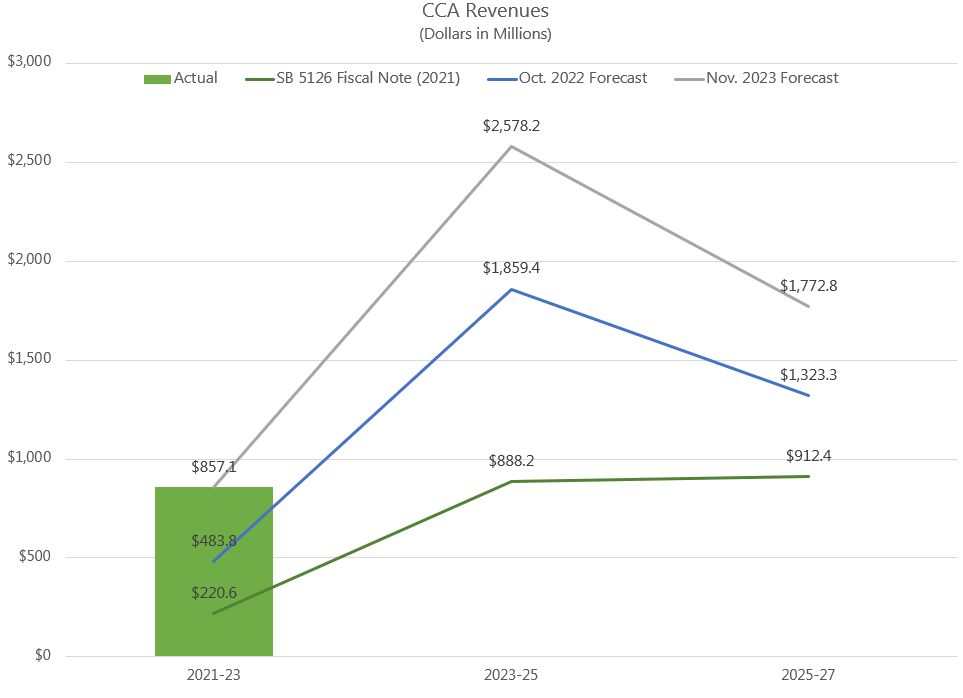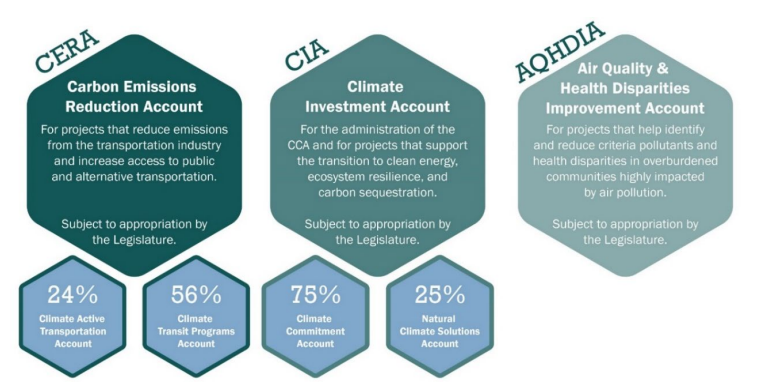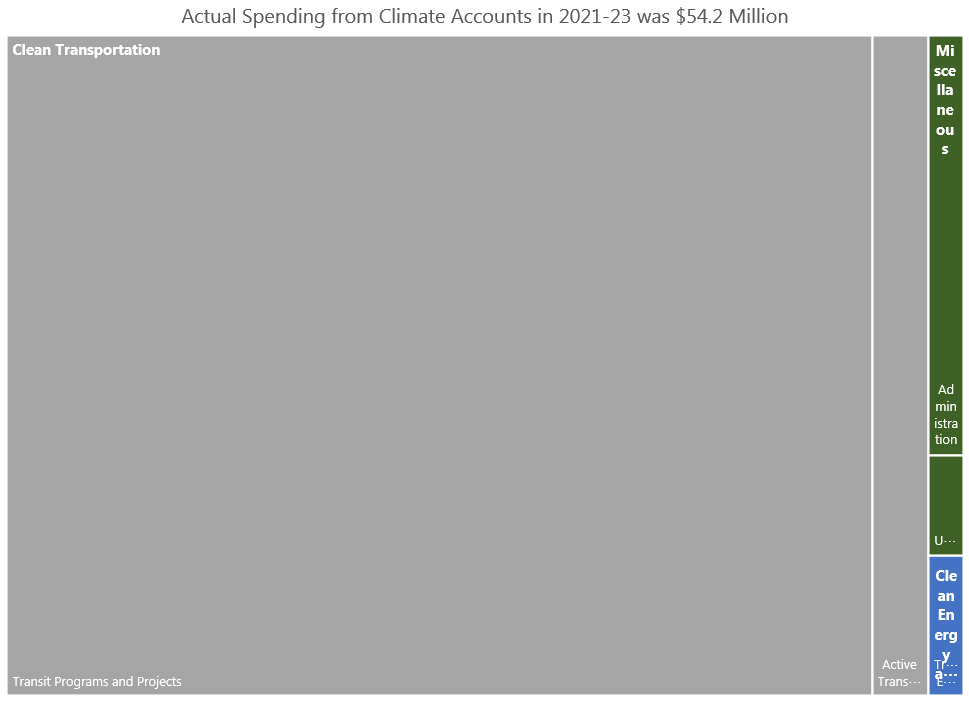1:22 pm
January 17, 2024
The state’s current forecast of carbon emission allowance auction proceeds estimates that revenues will be $1.092 billion higher than expected when the 2023–25 biennial budget was enacted last year. Gov. Inslee’s supplemental budget proposals would appropriate $915.2 million of that.
Revenues
The climate commitment act (CCA) was enacted in 2021. The first carbon emission allowance auction was held in Feb. 2023. CCA revenues are not included in the state’s operating budget revenue forecast or the transportation revenue forecast. Instead, Ecology has developed CCA revenue forecasts—in Oct. 2022 and Nov. 2023. (Going forward, Ecology will issue forecasts in June and November.)
Actual revenues for FY 2023 (the first year with auction revenue and the final year of the 2021–23 biennium) totaled $857.1 million, which was $373.3 million higher than forecasted in Oct. 2022. The Nov. 2023 forecast estimates that revenues for 2023–25 will be $2.578 billion ($718.8 million higher than forecasted in Oct. 2022) and revenues for 2025–27 will be $1.773 billion ($449.4 million higher than forecasted in Oct. 2022). The chart below compares the forecasts.

The forecast includes pessimistic (based on prices in the California/Quebec market) and optimistic (based on the average Washington auction prices) forecasts. The baseline forecast is based on a price that is midway between the pessimistic and optimistic scenarios. The baseline thus takes into account the possibility that the Washington market will be linked to that of California/Quebec. Ecology writes, “We are confident that the linkage price will be greater than the current California price, and less than the current Washington price.” (A linkage bill—SB 6058/HB 2201—has been heard by committee.)
The enacted 2023–25 budget was based on the Oct. 2022 forecast, so the Nov. 2023 forecast means that the Legislature will have $1.092 billion more to work with this year (that’s the increase for 2021–23 and 2023–25). However, as Ecology notes in the forecast,
as Washington’s cap-and-invest program is still very new, there remains a high level of uncertainty in any estimates of auction proceeds into the future. While the updated projections above represent Ecology’s best estimate of potential revenues, actual auction proceeds could be higher or lower, depending on the actual price that allowances sell for at each auction (the settlement price). Because of this inherent uncertainty, we strongly recommend caution when relying on these forecasted projections to appropriate funds from the associated accounts. Historically, the early years of emissions trading systems such as Washington’s are the most variable in allowance prices, and therefore in revenue.
(Additionally, I-2117 has been certified for the ballot, so voters could repeal the CCA in November.)
By statute, the auction proceeds are distributed to three accounts and four subaccounts. The illustration below is from Ecology. Because the statute specifies the dollar amount that must go to the carbon emissions reduction account and the Legislature has said it intends to put a fixed amount in the air quality & health disparities improvement account, the climate investment account (and its subaccounts, the climate commitment account and the natural climate solutions account) is the beneficiary of the increased revenues.

Spending
For 2021–23, the Legislature appropriated $76.2 million from the climate accounts (as revised in the 2023 supplemental) across the operating and transportation budgets. However, as this report from Ecology shows, only $54.2 million of that was actually spent. Enacted 2023–25 appropriations from the climate accounts totaled $2.130 billion across the operating, transportation, and capital budgets. Gov. Inslee has proposed increasing those 2023–25 appropriations by $915.2 million as part of his 2024 supplemental budgets.
The table summarizes the 2021–23 spending, enacted 2023–25 appropriations, and the governor’s proposed supplemental appropriations of the carbon auction proceeds. The spending/appropriations are shown by category, budget, and account. (The categories are based on the categories used by the governor’s office here and here.)

The charts below show more information about how the money is used, by spending categories. I’ve also put together a spreadsheet that provides even more spending detail, including the specific projects and programs that are funded, in which budget, and from which account. (Note that many of these items also receive funding from other sources; the numbers in the spreadsheet only show how much is coming from the climate accounts.)

Of actual 2021–23 spending, $33.4 million was used for transit support grants.

Major policies funded in 2023–25 include:
- $188.9 million for free transit for people who are 18 years old and younger
- $120.0 million for zero-emission commercial vehicle infrastructure and incentives
- $80.0 million for home electrification and appliance rebates
- $78.1 million for transit access for people with special needs
- $74.0 million for ferry vessel and terminal electrification
- $70.0 million to purchase carbon sequestration and storage property
- $50.0 million for ultra high speed rail
- $46.6 million for transit projects
- $41.0 million for local government climate planning

Major proposals in Gov. Inslee’s 2024 supplemental budgets include:
- $150.0 million for energy vouchers for low-income residents
- $136.5 million for green jobs and infrastructure grants
- $100.0 million for retrofit and heat pump installation for low-income multifamily homes
- $100.0 million for clean energy community grants
